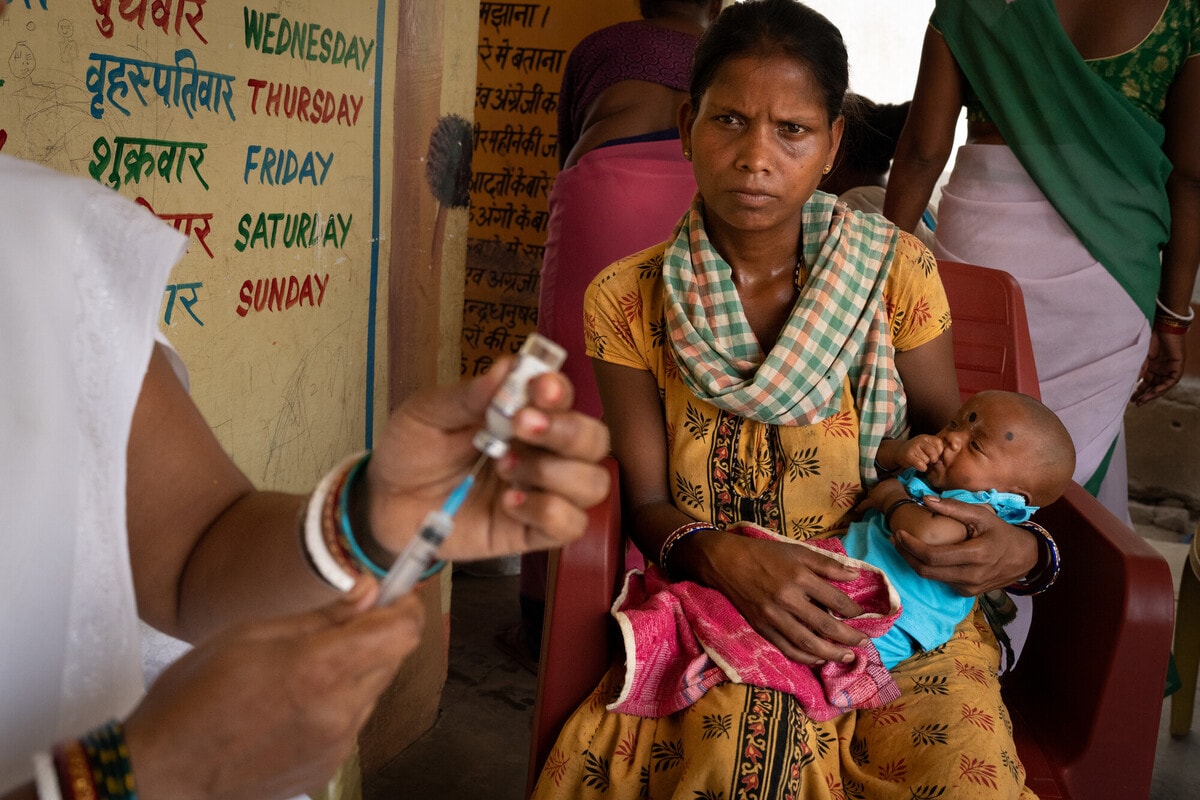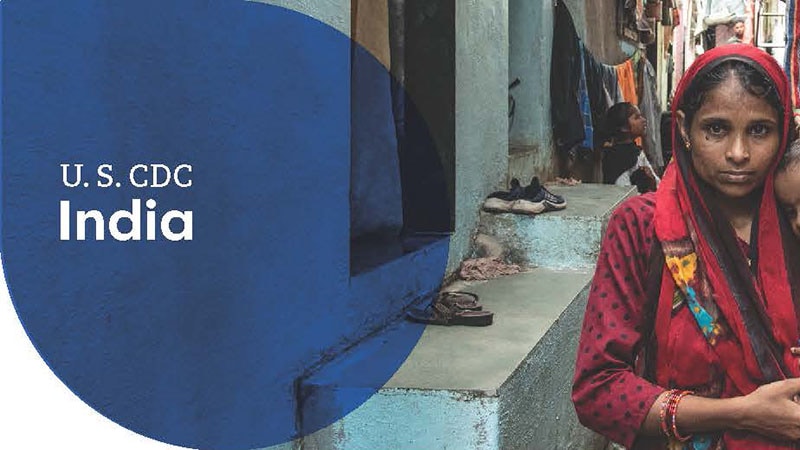At a glance
CDC works with the Ministry of Health and Family Welfare and other partners to build effective public health collaboration and partnerships, which strengthen the country's core public health capabilities: data and surveillance, laboratory capacity, workforce and institutions, prevention and response, innovation and research, and policy, communications, and diplomacy.

Overview

© UNICEF/U.S. CDC/UNI421369/Ahmad
CDC has worked in India for over 50 years. CDC India works closely with the Ministry of Health and Family Welfare and partner organizations to detect, prevent and control infectious disease outbreaks and build and strengthen the country's core public health capabilities. These include data and surveillance, laboratory capacity, workforce and institutions, prevention and response, innovation and research, and policy, communications, and diplomacy. CDC's work aims to protect the health of our nations and public health around the world.
Improving public health systems
CDC supports global health security priorities in India by providing technical expertise in strengthening public health systems to prevent, detect, and respond to emerging infectious diseases. Efforts include:
- Evidence-based technical guidance for Integrated Public Health Laboratory (IPHL)
- Leading One Health efforts to adapt training programs
- Prioritizing infectious disease implementation
- Strengthening surveillance and reporting for AMR
CDC has supported training for over 20,000 workers in epidemiology and disease surveillance, public health emergency management, laboratory diagnostic testing, and biosafety and quality management.
Laboratory systems
CDC is collaborating with Government of India (GoI) to develop a tiered lab network capable of detecting emerging and novel pathogens such as Nipah, influenza and others. CDC supports GoI initiatives to improve and serve as a regional leader in:
- Diagnostic capabilities
- Quality management systems
- Biosafety and biosecurity practices
- Specimen referral and transport
- Genomic surveillance
Key achievements
- Strengthened molecular detection capabilities for emerging pathogens.
- Developed and implemented IPHLs and their scale-up across all 730 districts. IPHLs have streamlined district and block level lab practices and increased lab diagnostic capacity.
- Trained in the application of evidence-based techniques for sub-district, district, and state referral labs.
- Supported the National Institute of Epidemiology to build capacity for whole genome sequencing of antimicrobial-resistant bacteria.
Workforce development
CDC's Field Epidemiology Training Program (FETP) strengthens the public health workforce's abilities to detect, respond, and control disease outbreaks at the source. To meet international health regulation targets, India needs to train over 7,000 epidemiologists. To help achieve this goal, CDC supported the establishment of an advanced FETP, India Epidemic Intelligence Service (India EIS) in 2012. Since then, India FETP has expanded to three hubs, training over 200 officers per year, across three FETP tiers (advanced, intermediate, and frontline). Since 2012, India FETP officers investigated over 550 outbreaks and conducted over 300 surveillance evaluations.
Key accomplishments
- Championed the development and release of a "One-India" FETP Roadmap, which lays the vision for FETP in India.
- Supported India FETP in launching two new initiatives to support FETP faculty development – an India EIS faculty cohort and a two-year public health workforce fellowship.
- Provided support to 'SectorConnect' (a One-Health Frontline FETP) and a one-year informatics program (Growing Experience in E-Learning and Knowledge, or GEEKS).
- Collaborated with GoI, WHO, and the South Asia Field Epidemiology Training Network to develop an India FETP learning management system platform. The platform will be instrumental in expanding a cadre of highly skilled field epidemiologists through a scalable learning approach.
Emergency management
CDC collaborates with GoI to enhance India's emergency management capabilities and resilience. Through national technical working groups, CDC provides technical assistance to implement modern emergency management concepts and principles, using a common framework for public health response, and exercises for pandemic preparedness. CDC aims to:
- Increase emergency management human resource capacity
- Strengthen national and sub-national emergency operations centers (EOCs)
- Develop and update emergency response plans, protocols, and procedures
- Build and sustain crisis and risk communication capacity
- Enhance points of entry preparedness and response capabilities
- Train and equip rapid response teams with management and operations competence
- Offer real-time support for multiple activations of EOCs and outbreak response systems
Key accomplishments
- Supported the establishment, operation, and management of national and sub-national EOCs that can coordinate and direct response to disease outbreaks, natural or humanmade disasters, and other public health emergencies.
- Collaborated to create, develop, establish, and maintain a comprehensive five-tiered Public Health Emergency and Disaster Management Professional Development Program. This program aims to develop preparedness and response capacity for the entire spectrum of the response workforce, from community members to professionals and policymakers.
- Support training for multisectoral personnel to effectively respond to public health emergencies and disasters, thereby fostering the development of a strong, adaptable, and resilient emergency management workforce.
Antimicrobial resistance (AMR)
CDC has been supporting the National Center for Disease Control (NCDC), GoI, to establish the National Antimicrobial Surveillance Network (NARS-NET) to improve quality assured testing, standardize scopes of practice, and conduct trainings. NARS-NET has increased from 10 laboratories in 2013 to include 60 laboratories across 27 states and 6 union territories.
CDC supports NCDC in strengthening the state level AMR surveillance networks. This support includes training and conducting reviews in seven Indian states. CDC supports AIIMS in partnership with the Indian Council for Medical Research to develop and implement a network for surveillance and prevention of healthcare associated infections.
Key accomplishments
- More than 200 intensive care units report to AIIMS. These reports include nearly 60 hospitals that conduct surveillance for bloodstream infections, urinary tract infections, and surgical site infections. An additional 40 medical college hospitals are enrolled through the NCDC, and 750 district hospitals across the country will be enrolled to the network.
- AIIMS prepares and and shares quarterly reports with Ministry of Health and Family Welfare (MoHFW) and key stakeholders, including WHO.
- Through CDC support, the network uses virtual training programs to build capacity to reduce HAIs and improve infection prevention and control programs using quality improvement methodology.
- Contribute to NCDC, GOI technical advisory and core working groups on AMR, infection prevention and control, and Antimicrobial Stewardship Program to develop and implement a National Action Plan on Antimicrobial Resistance.
HIV and TB
As a key implementer of the U.S. President's Emergency Plan for AIDS Relief (PEPFAR), CDC plays an essential role in the fight against HIV and TB. With unmatched scientific and technical knowledge and long-standing relationships with ministries of health, CDC is uniquely positioned to advance HIV, TB, and other global health security activities that keep Americans safe at home and abroad.
Through PEPFAR, CDC provides critical support to India's public health infrastructure, improving the country's ability to prevent, detect, and respond to HIV, TB, and other infectious diseases and minimizing their risk from entering the U.S.
Influenza
CDC helps India prepare for pandemics in alignment with India's "Pandemic Influenza Preparedness and Response Plan". CDC works to strengthen laboratories and training clinicians on effective case management and infection control. Strong influenza surveillance has enabled India to detect influenza seasonal peaks during monsoons, understand the seasonality of influenza in tropical countries, and guide timing for influenza vaccination.
Key accomplishments
- Collaborated with the All India Institute of Medical Sciences (AIIMS) to help determine the disease and economic burdens of influenza and other respiratory viruses in priority groups, evaluate effectiveness of influenza vaccines, and identify optimal timing for influenza vaccination.
- Fostered collaboration in influenza prevention and control among diverse stakeholders, including government bodies, healthcare professionals, researchers, and professional organizations in India through multiple stakeholder meetings during 2022-23 period involving representatives from more than 15 states.
- Advanced molecular diagnostic capacity developed during CDC's collaborations with National Institute of Virology. Efforts were made to scale up PCR SARS-CoV-2 testing across India's influenza laboratory network.
- Strengthened the influenza surveillance network by building lab capacity for rapid detection of viruses and emerging pathogens. This includes building capacity for molecular diagnostics (RT-PCR and genetic sequencing) and providing critical supplies.
- Supported trainings on Flu-COVID-19 RT-PCR and NGS for participants from medical colleges across India regions (Karnataka, Kerala, Andhra Pradesh, Rajasthan, Madhya Pradesh, Jammu & Kashmir, West Bengal, Sikkim, Meghalaya, and Assam).
Vaccine-preventable diseases (VPDs)
CDC supports efforts to eliminate or control vaccine-preventable diseases through the Universal Immunization Program. Since the mid 1990's, CDC has helped strengthen:
- Epidemiology and laboratory methods
- Routine immunization services
- Training methods, data systems
- Case-based disease surveillance
- Outbreak preparedness and response
CDC's support of the National Public Health Surveillance Project strengthened implementation of polio, measles, and COVID-19 vaccination campaigns, outbreak response, and surveillance.

